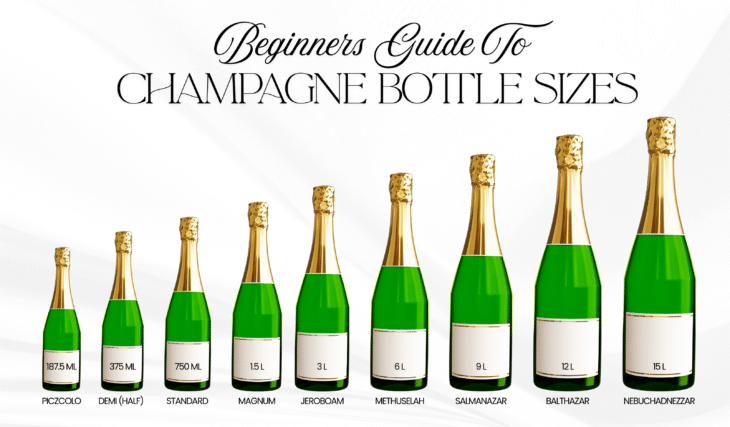Champagne Bottle Sizes Explained: From Piccolo to Nebuchadnezzar
When a bottle of champagne is brought to the table, the moment instantly feels more special. The sparkle of the glass, the soft pop of the cork, and the golden bubbles rising to the surface signal joy, celebration, and togetherness. Yet the size of the bottle itself carries its own magic. From the single-glass piccolo and the half bottle for intimate moments, to the familiar standard and the magnum prized for aging, each one holds a different expression of celebration. The journey continues with the grand jeroboam, the impressive methuselah, the mighty salmanazar, the striking balthazar, and the unforgettable nebuchadnezzar that can fill over a hundred glasses.
Each of these bottles does more than measure volume. They shape experiences, turning simple toasts into treasured memories. Some are perfect for a quiet dinner for two, while others belong at weddings, galas, or milestone events where size and spectacle matter. Whether small enough to hold in one hand or so large they require special cradles to pour, champagne bottles remind us that this drink is not only about taste but about how we share it, how we honor life’s milestones, and how we create moments that sparkle long after the last glass is poured.
Key Takeaways:
- Champagne bottles range in size from the piccolo with a single glass to the monumental melchizedek that holds forty bottles’ worth, each size carrying its own purpose and symbolism.
- The magnum is the ideal size for aging, offering balanced oxidation and richer flavor development compared to smaller bottles.
- Larger formats are rare and costly, often reserved for luxury events, auctions, or collectors due to their limited production.
- Oversized bottles are about spectacle as much as wine, seen at weddings, banquets, Formula 1 podiums, and luxury venues.
- Choosing the right bottle size depends on the occasion, balancing the number of guests with the kind of memory you want to create.
Champagne Bottle Sizes Chart
Understanding champagne bottle sizes at a glance makes it easier to choose the right one for your occasion. Whether you are sharing a quiet toast for two or hosting a celebration with hundreds of guests, each size offers its own balance of elegance, practicality, and spectacle.
| Bottle Name | Volume | Equivalent in Standard Bottles | Approximate Servings (Glasses) |
| Piczcolo | 187.5 ml | ¼ bottle | 1 glass |
| Demi (Half) | 375 ml | ½ bottle | 2 glasses |
| Standard | 750 ml | 1 bottle | 5–6 glasses |
| Magnum | 1.5 L | 2 bottles | 10–12 glasses |
| Jeroboam | 3 L | 4 bottles | 20–24 glasses |
| Methuselah | 6 L | 8 bottles | 40–48 glasses |
| Salmanazar | 9 L | 12 bottles | 60–72 glasses |
| Balthazar | 12 L | 16 bottles | 80–96 glasses |
| Nebuchadnezzar | 15 L | 20 bottles | 100–120 glasses |
The Standard Champagne Bottle
The standard champagne bottle holds 750 milliliters, enough for five to six glasses. It is the format most people picture when they think of champagne and serves as the universal benchmark for all other bottles. Nearly every champagne house bottles their wine in this size first, making it the most widely available option.
Its enduring popularity comes from both tradition and practicality. A standard bottle is easy to store, pour, and chill, making it ideal for casual toasts, anniversaries, or a special dinner. It strikes the perfect balance between convenience and celebration.
Examples of champagnes in standard bottles:
- Moët & Chandon Brut Impérial
- Veuve Clicquot Yellow Label
- Laurent-Perrier La Cuvée Brut
- Dom Pérignon Vintage
- Taittinger Brut Réserve
Small Champagne Bottle Sizes
Piccolo (187.5 ml)
The piccolo, meaning “small” in Italian, is the tiniest champagne bottle available. Holding just 187.5 milliliters, it equals one generous glass of champagne. This size is often chosen for single servings on flights, welcome gifts at events, or when you want a taste of luxury without committing to a full bottle. Its charm lies in its portability and the way it turns even the simplest moments into a celebration.
Examples of champagnes in piccolo size:
- Moët & Chandon Brut Impérial Mini
- Veuve Clicquot Yellow Label Mini
- Nicolas Feuillatte Brut Mini
Demi or Half Bottle (375 ml)
The demi, also called the half bottle, contains 375 milliliters of champagne, or about two glasses. It is perfect for a romantic dinner, a light aperitif, or for those who want to enjoy champagne without leaving an unfinished bottle. Many champagne houses offer half bottles, making it easier to sample different styles without opening a full-sized version.
Examples of champagnes in half bottle size:
- Bollinger Special Cuvée Half Bottle
- Ruinart Blanc de Blancs Demi
- Pol Roger Brut Réserve Half Bottle
Large Champagne Bottle Sizes
Magnum (1.5 L)
The magnum is one of the most celebrated champagne bottle sizes, holding 1.5 liters, or the equivalent of two standard bottles. It pours about 10 to 12 glasses, making it a favorite for dinner parties and small gatherings. Beyond its practicality, the magnum has earned a special reputation among wine lovers because champagne ages more gracefully in this format. The slower oxidation process inside the larger bottle allows flavors to develop with greater depth and harmony, which is why collectors and sommeliers often consider it the “ideal” size for cellaring.
Pouring from a magnum also creates an undeniable sense of occasion. Its weight, presence, and the dramatic unveiling at the table instantly elevate the mood of any celebration.
Examples of champagnes available in magnum size:
- Louis Roederer Cristal Magnum
- Moët & Chandon Grand Vintage Magnum
- Veuve Clicquot La Grande Dame Magnum
- Pol Roger Sir Winston Churchill Magnum
Jeroboam (3 L)
The jeroboam holds 3 liters of champagne, equal to four standard bottles and about 20 to 24 glasses. Its name, like many of the larger formats, comes from a biblical king, reflecting a long tradition of associating champagne’s grandeur with figures of power and legacy. The jeroboam is often chosen for weddings, milestone birthdays, and luxury events where the bottle itself becomes a centerpiece as memorable as the champagne inside.
Beyond its commanding presence, the jeroboam also preserves champagne beautifully, allowing the flavors to evolve slowly over time. For collectors, it offers both prestige and practicality. For hosts, it guarantees a dramatic pour that captures everyone’s attention.
Examples of champagnes available in jeroboam size:
- Dom Pérignon Vintage Jeroboam
- Veuve Clicquot Yellow Label Jeroboam
- Perrier-Jouët Belle Époque Jeroboam
- Bollinger Special Cuvée Jeroboam
Methuselah (6 L)
The methuselah holds 6 liters of champagne, the equivalent of eight standard bottles or around 40 to 48 glasses. Named after the biblical figure known for his long life, this size symbolizes endurance and grandeur. It is a popular choice for large-scale celebrations, often unveiled at weddings, anniversaries, and holiday banquets where the sheer size of the bottle sets the tone for festivity.
Opening a methuselah is a true spectacle. Its weight and volume often require two people to pour, and its presence on a table or at a bar instantly commands attention. Beyond its visual impact, the larger volume helps champagne age gracefully, allowing the flavors to stay fresh while deepening in complexity.
Examples of champagnes available in methuselah size:
- Moët & Chandon Impérial Brut Methuselah
- Louis Roederer Cristal Methuselah
- Taittinger Comtes de Champagne Methuselah
- Laurent-Perrier Cuvée Rosé Methuselah
Salmanazar (9 L)
The salmanazar contains 9 liters of champagne, equal to twelve standard bottles or roughly 60 to 72 glasses. Its name is rooted in ancient Assyrian kings, continuing the tradition of linking large-format bottles with figures of power and legacy. This size is rarely seen outside of major banquets, gala dinners, or luxury events, where it is designed to impress as much as it is to serve.
The sheer presence of a salmanazar creates instant drama. It often becomes a focal point of the celebration, standing tall at the center of a table or displayed on a stage before being opened with ceremony. Pouring from it requires skill, sometimes even special cradles, but the result is unforgettable. It is a bottle that not only serves champagne but also makes a statement of grandeur and extravagance.
Examples of champagnes available in salmanazar size:
- Veuve Clicquot Yellow Label Salmanazar
- Moët & Chandon Impérial Brut Salmanazar
- Perrier-Jouët Belle Époque Salmanazar
- Bollinger Special Cuvée Salmanazar
Balthazar (12 L)
The balthazar holds 12 liters of champagne, equal to sixteen standard bottles or about 80 to 96 glasses. Named after one of the Three Wise Men, it carries a sense of reverence and majesty. This size is typically reserved for the grandest occasions, from royal banquets to high-profile galas, where the act of presenting and pouring the bottle is just as important as the champagne itself.
The spectacle of a balthazar is unmatched. Weighing nearly 40 pounds when full, it usually requires two people to lift and pour. Its rarity and commanding presence make it a collector’s treasure and a centerpiece of unforgettable celebrations. Beyond its show-stopping size, it also offers excellent aging potential, preserving the champagne’s finesse while magnifying its depth and complexity.
Examples of champagnes available in balthazar size:
- Dom Pérignon Vintage Balthazar
- Louis Roederer Cristal Balthazar
- Veuve Clicquot La Grande Dame Balthazar
- Moët & Chandon Impérial Brut Balthazar
Nebuchadnezzar (15 L)
The nebuchadnezzar is one of the most legendary champagne bottle sizes, holding 15 liters, equal to twenty standard bottles or about 100 to 120 glasses. Its name comes from the ancient Babylonian king, reflecting strength, power, and magnificence. The sheer scale of this bottle makes it a rare sight, often reserved for once-in-a-lifetime events such as royal celebrations, luxury yacht parties, and prestigious corporate galas.
Opening a nebuchadnezzar is more than pouring champagne. It is a performance that captures attention and leaves a lasting impression on everyone present. Its weight and size mean that specialized equipment or multiple people are needed to serve it, which only adds to the drama. Beyond its commanding presence, the vast volume allows the champagne to age gracefully, maintaining freshness while developing a depth that smaller bottles cannot replicate.
Examples of champagnes available in nebuchadnezzar size:
- Moët & Chandon Impérial Brut Nebuchadnezzar
- Veuve Clicquot Yellow Label Nebuchadnezzar
- Laurent-Perrier Cuvée Rosé Nebuchadnezzar
- Louis Roederer Cristal Nebuchadnezzar
Rare and Extra-Large Champagne Bottles
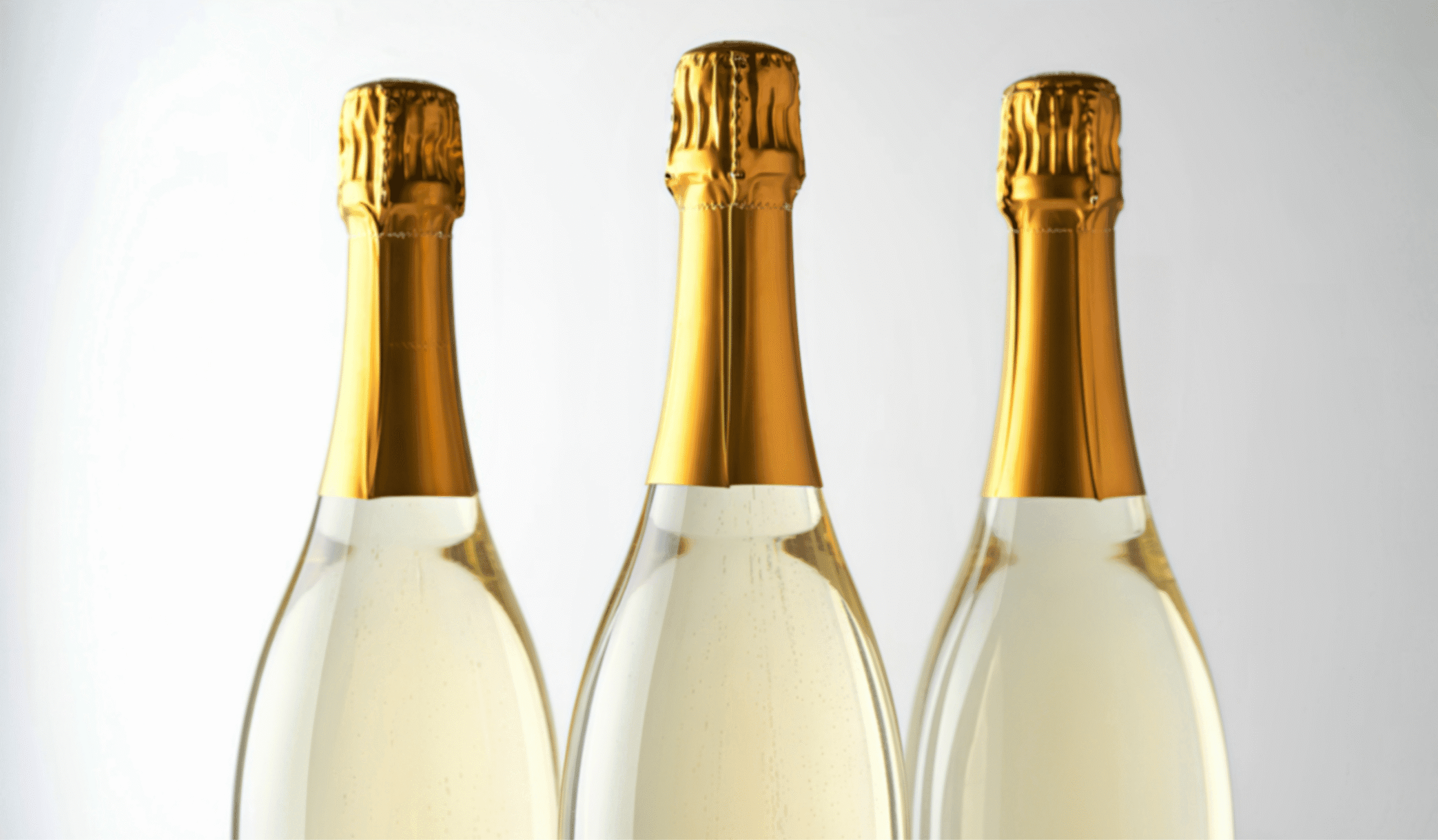
While the nebuchadnezzar often feels like the pinnacle of grandeur, there are even rarer bottles that stretch imagination and scale. These formats are seldom produced, often reserved for historic events, luxury auctions, or as one-of-a-kind collector’s items. Their presence is as much about spectacle as it is about wine.
Melchior (18 L, 24 bottles)
The melchior contains 18 liters of champagne, equivalent to twenty-four standard bottles. It pours roughly 120 to 144 glasses and is named after one of the Three Wise Men. Because of its biblical association, it carries a sense of reverence and majesty. Melchiors are occasionally unveiled at world-class banquets or high-profile celebrations where the bottle itself is the centerpiece.
Solomon (20 L, 26 bottles)
The solomon holds 20 liters, or about twenty-six standard bottles. Its size makes it more of a statement piece than a practical serving vessel. This rare bottle often appears at prestigious events and is treasured by collectors for its rarity.
Sovereign (26.25 L, 35 bottles)
The sovereign is even larger, containing over 26 liters of champagne, equal to thirty-five standard bottles. Very few champagne houses have produced this size, and when they do, it is usually for monumental occasions such as world records or historic ceremonies. Its presence is designed to astonish, reinforcing champagne’s role as a symbol of luxury and celebration.
Primat or Goliath (27 L, 36 bottles)
The primat, sometimes called the goliath, contains 27 liters, equivalent to thirty-six standard bottles or around 180 to 216 glasses. This colossal bottle rarely leaves the cellars of champagne houses, but when presented, it becomes the ultimate showpiece. Its sheer scale requires specialized equipment for pouring, and its unveiling is an event in itself.
Melchizedek (30 L, 40 bottles)
The melchizedek is the largest known champagne bottle in existence, holding 30 liters, equal to forty standard bottles and more than 200 glasses. Named after a biblical king and priest, it symbolizes the ultimate in grandeur. These bottles are extraordinarily rare, and their production is as much a feat of engineering as it is of winemaking. A melchizedek is less about practicality and more about spectacle, often reserved for world records, luxury yachts, and celebrations where extravagance knows no bounds.
What Size of Champagne Bottle Is Best for Sabering
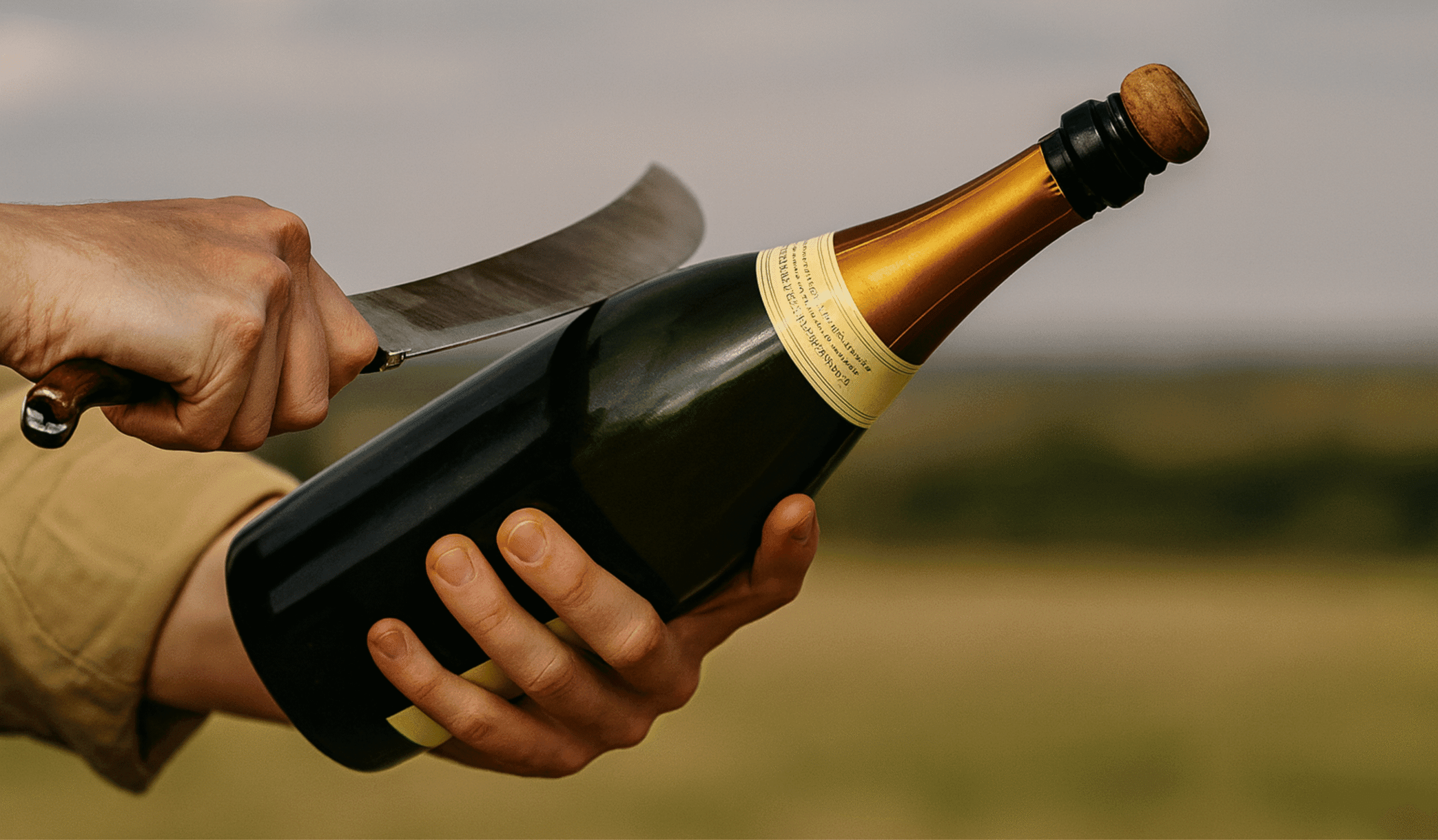
Sabering, the dramatic act of opening a bottle of champagne with a saber, works best with standard sized bottles. A 750 ml standard bottle has the right pressure, glass thickness, and manageable weight to create a clean break at the lip when struck correctly. The carbonation inside builds enough force to push the cork and glass collar away safely, which is why this size is the classic choice for sabrage.
Magnums at 1.5 liters can also be sabered for added spectacle, but they require more strength and control because of their heavier weight. Bottles larger than a magnum are generally impractical and unsafe to saber, since the glass is thicker and the size makes them difficult to handle securely. Smaller bottles such as piccolos or half bottles often do not have enough internal pressure for a clean saber, which can result in shattered glass instead of a smooth opening.
For both safety and show, the 750 ml standard bottle remains the most reliable choice for sabering. It combines elegance, tradition, and a predictable result, ensuring the cork flies free in one smooth motion. Always practice caution, point the bottle away from people and fragile objects, and choose a safe setting before performing sabrage at any celebration.
Why Champagne Bottle Sizes Have Biblical Names
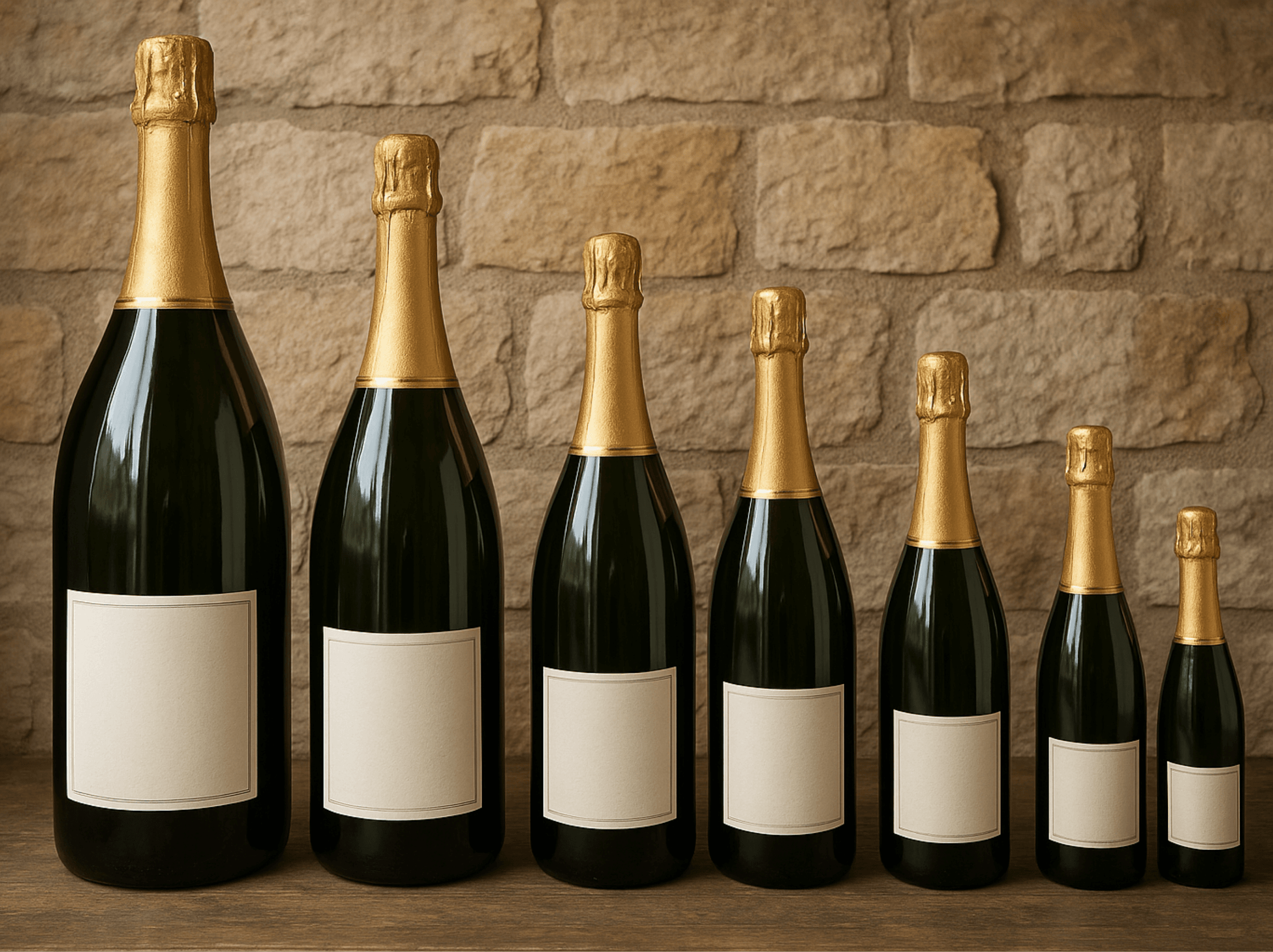
The tradition of naming large champagne bottles after biblical kings and patriarchs reflects both history and symbolism. In biblical times, figures such as Jeroboam, Methuselah, and Nebuchadnezzar were associated with power, longevity, and grandeur. By borrowing these names, champagne houses connect their bottles with a sense of timelessness and reverence.
The symbolism extends beyond religion into the very essence of champagne. Larger bottles represent endurance, celebration, and legacy, qualities that mirror the occasions where they are most often used. Weddings, royal banquets, milestone anniversaries, and global events all find meaning in these names, linking the past to the present in a ritual of festivity.
Practical Considerations
Serving and Storage
Oversized champagne bottles are as challenging as they are impressive. Their sheer weight often requires two people to pour, or the use of specially designed cradles that keep the bottle steady while serving. Without this support, there is a risk of spills, wasted champagne, and even injury. Professional sommeliers are trained to handle these bottles gracefully, turning the act of pouring into a spectacle in itself.
Storage also demands forethought. Large-format bottles take up significant space and rarely fit standard wine racks or coolers. In cellars, they need custom shelving or horizontal placement to keep the cork moist and prevent air seepage. Proper temperature and humidity control become even more critical, as the champagne inside is meant to last decades in these formats.
Aging and Taste
Among all formats, the magnum (1.5 L) is widely regarded as the ideal size for aging. Its balanced ratio of wine to air space slows down oxidation while allowing gradual flavor evolution. Collectors and winemakers praise magnums for producing the most harmonious, long-lived expressions of champagne.
As the bottles increase in size beyond magnum, the oxidation rate slows even further. This means the champagne can remain vibrant for longer while developing layers of complexity. In effect, larger bottles not only impress visually but also preserve the integrity of the wine, making them prized assets for serious cellars.
Cost and Availability
While standard bottles and magnums are relatively easy to find, larger formats such as jeroboams, methuselahs, and beyond are produced in very limited numbers. Their rarity stems from the difficulty of production—special glass molds, reinforced bottling processes, and strict quality control are required to prevent breakage under pressure.
These factors make large bottles significantly more expensive, often commanding collector-level prices. They are typically reserved for prestigious releases, luxury events, or auction houses. Event planners and collectors often source them directly from champagne houses, specialized wine merchants, or private brokers who secure limited allocations.
Facts and Cultural References
Champagne’s grandeur is not limited to the bottle itself. Over the years, oversized bottles have become icons of spectacle, prestige, and celebration across the world.
Record-Breaking Moments
Champagne has a long history of being linked to milestones and records. At Formula 1 podiums, victorious drivers famously shake and spray champagne in a display that symbolizes triumph as much as tradition. Royal weddings have also featured enormous bottles, sometimes methuselahs or beyond, to honor the scale of the occasion. On luxury yachts, oversized formats such as nebuchadnezzars or even melchizedeks are opened with ceremony, adding to the glamour of exclusive gatherings at sea. These record-breaking pours are as much about performance as they are about enjoyment, creating unforgettable memories for everyone present.
Restaurants, Bars, and Branding
Beyond private celebrations, oversized champagne bottles often serve a decorative role. High-end restaurants and luxury bars display empty jeroboams, methuselahs, and even nebuchadnezzars as part of their interior design, turning them into symbols of prestige and indulgence. Some venues use them as focal points at entrances or behind the bar, signaling exclusivity to guests. For brands and champagne houses, these bottles are also powerful marketing tools. A single oversized bottle on display communicates legacy, abundance, and festivity in a way no standard format can achieve.
Choosing Your Perfect Bottle Size
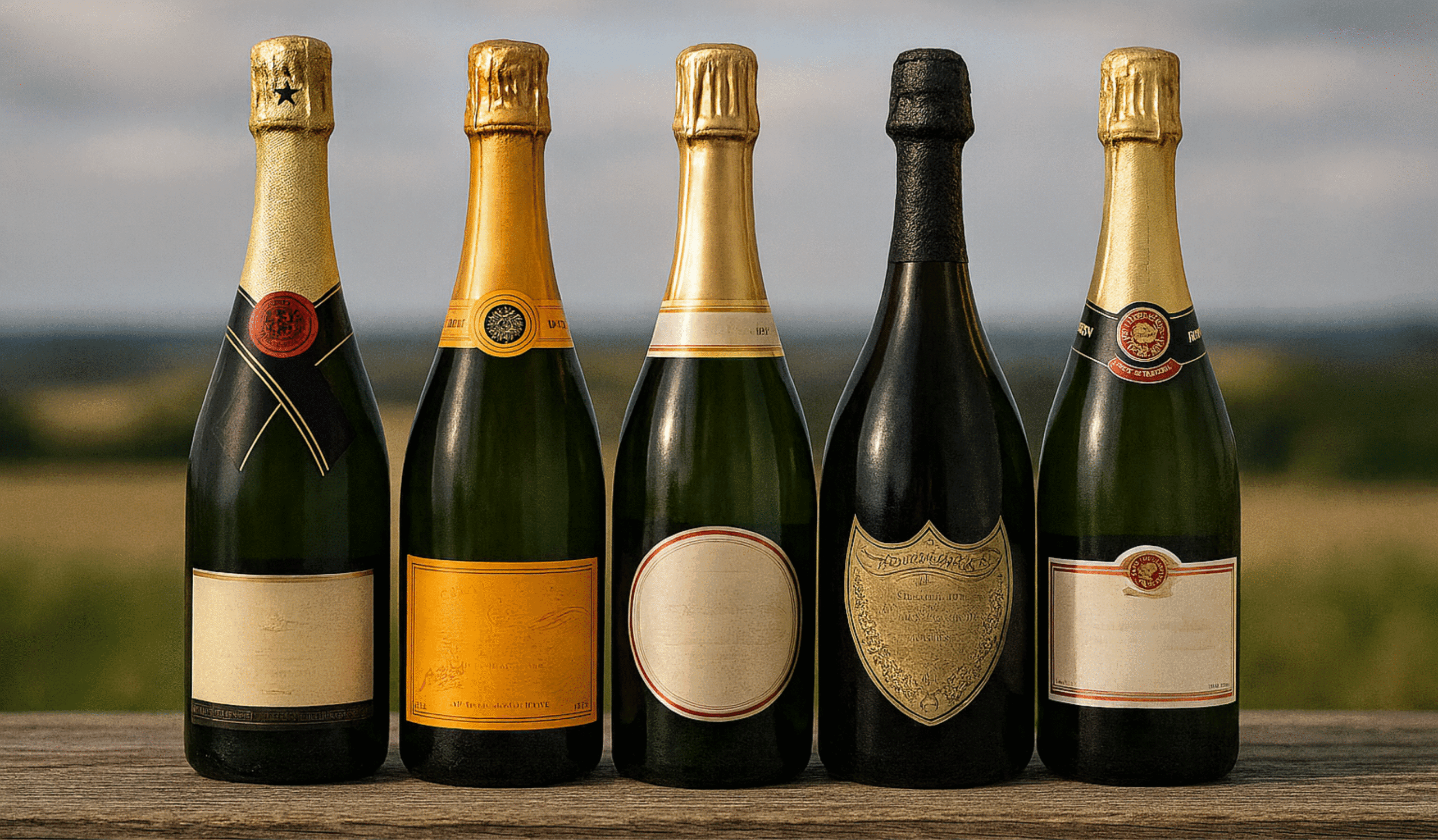
Every champagne bottle size offers its own character and purpose. The piccolo makes luxury accessible in a single glass, while the demi adds intimacy to a quiet dinner. The standard bottle remains the universal symbol of celebration, and the magnum is cherished for both its presence at the table and its ability to age champagne beautifully.
Larger bottles such as jeroboams, methuselahs, and salmanazars move beyond practicality to become showpieces, turning gatherings into grand occasions. At the far end of the scale, the monumental nebuchadnezzar and rare formats like the melchizedek are less about serving wine and more about making history.
When choosing your perfect bottle size, think not only about how many guests you are serving but also about the memory you want to create. Champagne is as much about the moment as the drink itself, and the right bottle ensures that every toast, whether small or spectacular, becomes a story worth remembering.
